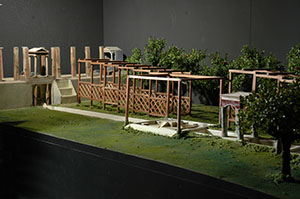 |
||
| [close] | ||
 |
© Institute and Museum of the History of Science |
The garden of the House of D. Octavius QuartioWorking model Opera Laboratori Fiorentini The hypothetical operation of the euripus and the whole garden irrigation system at the House of O. Quartio is illustrated here. From the city's aqueduct, water flowed into the cross arm, which was on a higher level than the rest of the garden. When it had filled, water fed the jets into the semicircular pool, and flowed down the gently sloping paving into a duct. By inundation, the water filled the pools below, along the mid-line of the garden, to end its course in a cistern, which still remains to be excavated. All of the jets are fed by an external piping system that runs from the upper arm of the euripus to the fountains, bordering the pools in the garden. The tube then sinks underground and rises again at the nozzles. All of the pools are put in communication through holes in the walls between them, through an overflow canal in the aedicule, or through channels in the architectural structure, as in the case of the small temple. |